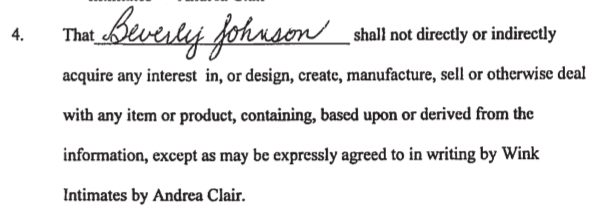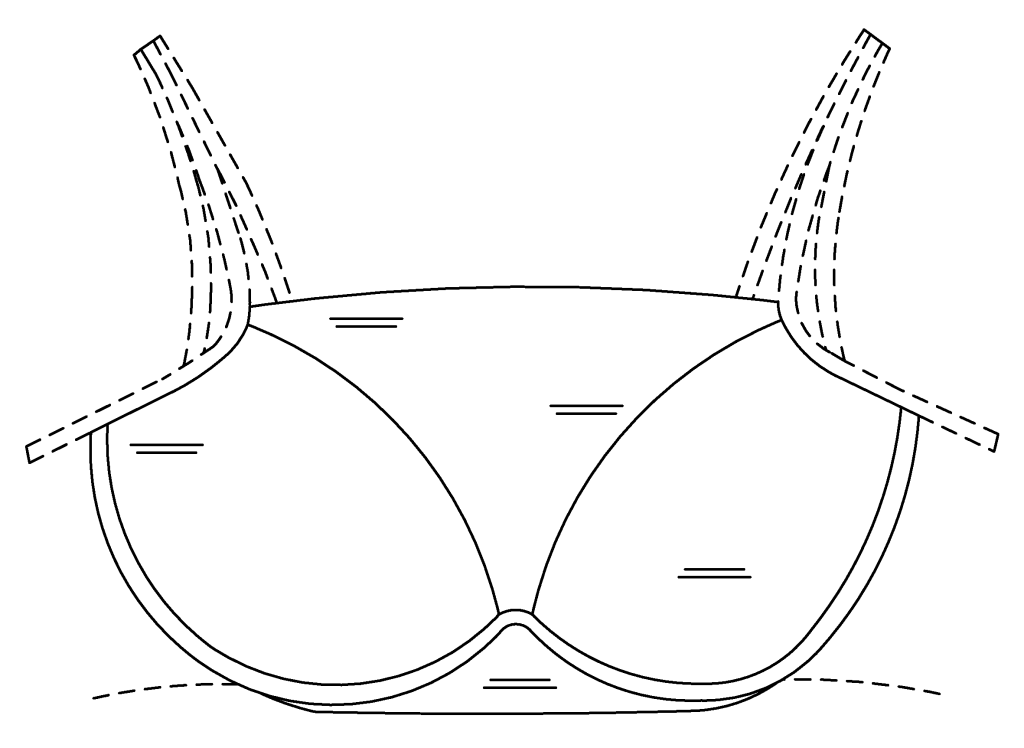You have someone sign an NDA that says this:
If you can’t read it, it says
4. Beverly Johnson shall not directly or indirectly acquire any interest in, or design, create, manufacture, sell or otherwise deal with any item or product, containing, based upon or derived from the information, except as may be expressly agreed to in writing by Wink Intimates by Andrea Clair.
The product in question was a women’s combination brassiere and tank top.
Beverly Johnson, who was in Canada, was hired to help reduce the invention to practice. She ended up adjudged as an unnamed joint patent inventor, despite the fact that she testified she didn’t think she was one.* Once it was decided Ms. Johnson was an inventor, the parties raced to get an assignment of her interest and the accused infringer, Chico’s, won.
What effect does the language in the NDA have? The patent owner, Wink, argued that the language meant that Ms. Johnson abandoned her inventorship interest and therefore could not assign it to Chico’s.
Although federal law applies to the validity of a patent assignment, this situation did not involve an assignment. Transfers other than by assignment are governed by state law, so here the court applied Canadian law. And relying on the parties’ Canadian law experts, the court held that under Canadian law there was not an abandonment—not because of the law of abandonment, but because the agreement didn’t contemplate inventorship:
At the time Johnson entered into this agreement, no one thought she was a co-inventor. The parties viewed Johnson as the owner of a bra-making store/school that assisted Clair with developing her invention further. Concerned that Johnson might assist other cami bra producers in the same manner using information gained during their relationship, Clair had Johnson execute the agreement. The language therein does not indicate in any way that Johnson maintained rights to the patents-at-issue. And it certainly does not indicate that Johnson was “giving up,” “deserting,” or “relinquishing” such rights. Johnson agreed to not design, create, manufacture, sell, or otherwise deal with competing items or products using information gained from Clair. Nothing more, nothing less.
Wink’s arguments to the contrary are unpersuasive. Wink argues that the words “[a]ny ‘item or product’ cover intellectual property,” including the patents-at-issue. As [Chico’s expert] explained, determining the meaning of words involves “a number of contextual factors, including the purpose of the agreement and the nature of the relationship created by the agreement.” The purpose of this agreement is clear: Clair did not want Johnson discussing information gained during their relationship with others, or using that information to help others develop similar cami bras. The parties viewed their relationship as client and consultant, not co-inventors waiving ownership rights. It is not feasible to conclude that the parties intended “any item or product” to mean future patents.
The NDA that Ms. Johnson signed specifically referred to the first patent application, so Wink characterized her agreement as a “willingness to surrender a potentially valuable right to work on the invention.” Instead the court found “Johnson could not have intended to abandon her ownership rights if not a single party to the agreement believed she possessed such rights.”
So once we have the defendant as a joint owner of the patent, not all inventors are joined as plaintiffs, as is required for standing for a patent infringement suit, and the case goes away.
Ok, so now when I review an NDA I will have to make sure that, if an ownership interest does arise in the course of the relationship (despite the agreement saying that none will), the agreement says what happens to that interest …
Chico’s FAS, Inc. v. Clair, No. 2:13-cv-792-TFtM-38MRM (M.D. Fla. Dec. 1, 2015).
*If you’re skeptical, as I was, read the opinion. She was totally an inventor.

The text of this work is licensed under a Creative Commons Attribution-No Derivative Works 3.0 United States License.



Leave a Reply